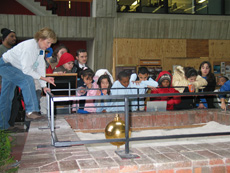Students visit Fermilab
to see science in action
Yesterday 40 students from the Science Academy of Chicago visited Fermilab to learn about life at a physics lab.
The younger students, 3rd, 4th and 5th graders, are currently learning chemistry and began their morning in the Lederman Science Center's lab. Felicia Svoboda, Fermilab docent, explained what colliders at Fermilab do and how the detectors help physicists study particles. Discussing the components of detectors, she held up several pieces of scintillating plastic. The ends glowed. A wave of "awe's" ran through the room. The kids learned that scintillating plastic is one of many types of polymers. Their science classes recently covered the concept of polymers and they are being tested on it later this week. 
Using borax, Elmer's glue and water the students conducted a mini experiment and made their own polymer. Here two students work together measuring the glue.
Do you know how Foucault's pendulum works? These students now do. 
Svoboda explained that while the pendulum's plane of swinging appears to gradually rotate, its motion is actually staying constant. It is the floor, and the earth beneath the floor, that rotates around it. The pendulum's rate of rotation is dependent on the latitude of where it is located. At Fermilab the rotation is every 36 hours.
Liquid nitrogen always makes for great demos. 
Ann Mary Teichert, Fermilab docent, showed that living tissue does not do well when frozen. Members of the older group of students, 6th, 7th and 8th graders, observed the shattering of leaves after they are dipped in liquid nitrogen. During the cryogenics demonstrations students saw that materials react to extreme cold in different ways. They could see that scientists working on cryogenics need to choose their materials carefully.
On the tour, the students also took in the 15th floor and a meeting with Fermilab scientist Denton Morris, an engineering physicist in the Accelerator Division. "This was a very enthusiastic group, they had a lot of energy," said Morris. Morris and the students discussed topics such as the scale of subatomic particles, for example--"If an orange were the size of the earth, would you be able to see the protons inside?" It's good to get them thinking young.
--D.A. Venton
|